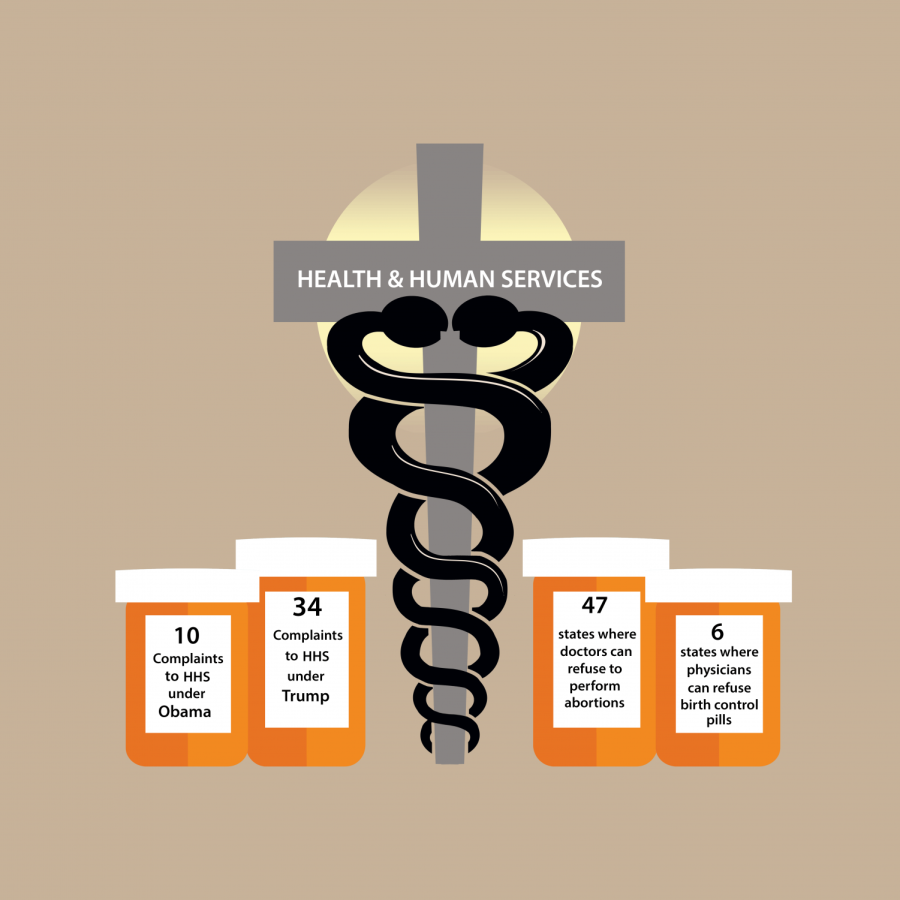New freedoms prioritize religion over patients
March 1, 2018
Immoral is the one word that comes to mind when thinking about the possibility of healthcare providers withholding information about a patient’s wellbeing. With the Department of Health and Human Services’ (HHS) implementation of the Conscience and Religious Freedom Division on Jan. 18, healthcare providers will now be given the opportunity to do just that — convince patients that they are healthy when they are not.
The goal of the newly created office is to enforce religious freedoms in medicine, allowing healthcare providers such as doctors, nurses and specialists the option to opt out of procedures that run contrary to their religious beliefs. The creation of the office, however, has opened doors for caretakers to endanger people seeking controversial procedures like abortion, sterilization and HIV prevention. There have been many cases in which healthcare providers have chosen not to inform patients of important information regarding their health. Choosing not to inform patients of necessary medical procedures is not acceptable. Those who decide against performing certain procedures should instead inform patients regarding the next steps in their care and refer them to professionals who may be able to provide them with the healthcare they need.
“Everybody is always going to have different opinions, but it is really important, for the sake of healthcare to stay impartial,” said senior Kimia Ghasemian, the president of the Pre-Medical club. “Doctors take a Hippocratic oath when they go into medical school to do what is best for their patients, and even if that means going against their own personal ideals, so be it.”
The Conscience and Religious Freedom Division was created in response to longstanding resentment toward the Obama administration for “trampling religious freedoms.” During the previous presidential administration, certain religious groups felt that they were not free to adhere to their religious beliefs when it came to healthcare. As a result, the new division rose to serve as an investigative unit of conscience objections and religious-freedom concerns in health care. The HHS also wrote a 216-page proposal detailing the extent to which the right wing would be changing the focus of medical treatment to be centered around the provider and not the patient. With the goal of catering to the provider’s comforts, the proposal also addresses the definition of “to assist.” Originally, for example, a nurse could opt out of aiding in the surgery of a gender change; now, that same nurse not only has the right to opt out of the procedure, but can also object to checking a transgender person into the hospital or taking their temperature. The extension of religious freedoms does not stop with nurses. All hospital staff, including the janitors, fall under the protection of the new division, which just extends the reach of people who now have the power to put lives at risk.
“Being able to understand and empathize with the patient and your colleagues, even if you have a different background or beliefs, is so important,” said Ghasemian. “Even if you do not agree, you have to understand what other people are going through or the kind of opinions other people have. After all, how are you going to treat them if you do not understand what they are going through?”
The effects of the new culture surrounding medical care are having real life consequences. In September 2016, the U.S. Court of Appeals for the Sixth Circuit ruled against allowing Michigan resident Tamesha Means to proceed with her case against the U.S. Conference of Catholic Bishops. 18 weeks pregnant, Means rushed to the Mercy Health Partners, a Catholic institution and the only hospital in her area, when her water broke. She was turned away under the impression that she was fine. What she was not told was that continuing her pregnancy would be dangerous and that an abortion was necessary. When she came back the next day with painful contractions, she was almost turned away again; having a miscarriage at Mercy Health Partners is what saved her. Despite her survival, the negligence when it came to how she was treated at the hospital and the court should not be dismissed.
“If an abortion is what the patient needs then that is what the patient should get, if it is in their best interest,” said health clerk and athletic trainer, Megan Gwozdecke. “I do not think that because you are pro-life and someone needs an abortion that you can say no because it is against your beliefs.”
It is unacceptable for religion to be put above healthcare. With its introduction of the Conscience and Religious Freedom Division, the Department of Health and Human Services has stated outright that religion should be given priority over a patient’s needs. The purported reasoning behind establishing the new division is a noble one — to bridge the gap between religion and medicine. When people start taking advantage of the protections they have by putting others’ health at risk, however, change needs to occur. Turning away patients based on religious preference is one thing, but lying to them about their health surpasses ethical boundaries and should not be permitted. Healthcare providers should have the right to choose to care for patients based on their own religious preferences, but they should do so with an understanding that the patient still requires healthcare.
“Healthcare providers should take religious beliefs into consideration, but regardless of beliefs they need to present all options,” said Gwozdecke. “It is so important to have an actual educated discussion with the family members or the patient.”
The Conscience and Religious Freedom Division should not pave the way for further neglect when it comes to providing patients with crucial healthcare. If certain medical procedures do not align with a physician’s beliefs, he or she should simply direct patients to someone who can provide the necessary aid.




































































